A Thousand Blows: How a historic women-only gang menaced London for decades
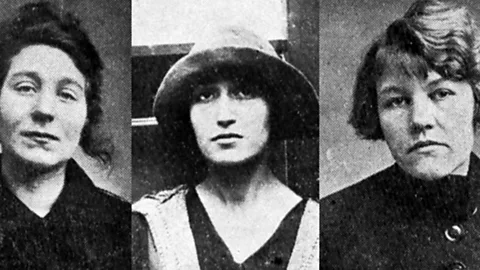 Police Gazette/ National Archives
Police Gazette/ National ArchivesThe all-female Forty Elephants lived by their own shoplifting and pickpocketing code. Now a new Disney+ series from the creator of Peaky Blinders tells the wild true story of the gang and its "queen", Mary Carr.
An organised crime gang operating in a capital city is hardly unusual. The Mafia, the yakuza and the triads, to name but a few, have all found rich pickings in cities across the world. What makes the Forty Elephants different, apart from their strange name, is the fact that they were a women-only syndicate. And they were led by a queen.
The story of the first of their leaders is dramatised in a lavish new six-episode Disney+ series from Peaky Blinders creator Steven Knight. A Thousand Blows revolves around Mary Carr, played by Erin Doherty, hitherto best known for her role as Princess Anne in The Crown, and another real historical figure, the gloriously named Hezekiah Moscow (Malachi Kirby), a Jamaican man who came to London in the late 19th Century.
Knight was initially approached by the production company set up by husband-and-wife team Stephen Graham and Hannah Walters (who both appear in the series) with the idea of writing a drama about Moscow. "A story about a real person who came from Jamaica with an ambition to become a lion tamer and became a really famous boxer? That's pretty much irresistible," Knight tells the BBC. "And when I dug into it and found out about this person and his experiences, it was very compelling. Before then, for a long time, I'd wanted to tell the story of the Forty Elephants. Both of those true stories are amazing, and the fact is they were both happening at the same time and in the same place. I thought it would be interesting to imagine what would have happened if Mary and Hezekiah had met – and that's what this show is about."
A Thousand Blows opens with Moscow and his friend, newly arrived in the British capital, witnessing Carr and her Elephants operating a pickpocketing scam near the docks. We soon learn that Carr has far grander ambitions and is planning an audacious heist. "Anyone can steal from the bottom," she tells her lieutenants. "It's time we stole from the top." She crosses paths with Moscow at the Blue Coat Boy, a pub owned by Henry 'Sugar' Goodson (Graham) – a fighter and another real historical figure – and she introduces herself as "the Queen of the Forty Elephants, the biggest, fastest, most independent gang of female thieves in the whole of London".
Reliable information about the real Mary Carr is scarce. We know that she was born in 1862 in Holborn, London, and that by 1881 she was an inmate at a female penitentiary in Kent, a strict facility for "fallen women" run by the Church of England. The precise reason for Carr's admission is unclear, but she had been convicted of shoplifting at the age of 14. Her mother was dead by then, and her father, a thief and fraudster, could have been in prison or abroad.
According to Brian McDonald's book Alice Diamond and the Forty Elephants, Carr had striking looks and worked as a flower seller in London's Covent Garden. She was also an artist's model for Dorothy Tennant, who published an illustrated book called London Street Arabs, and for Frederic Leighton, whose best-known work is Flaming June. Sometime around 1890, she was elected as "Queen" of the Forty Elephants, an organisation of around 40 women whose origin is shrouded in mystery.
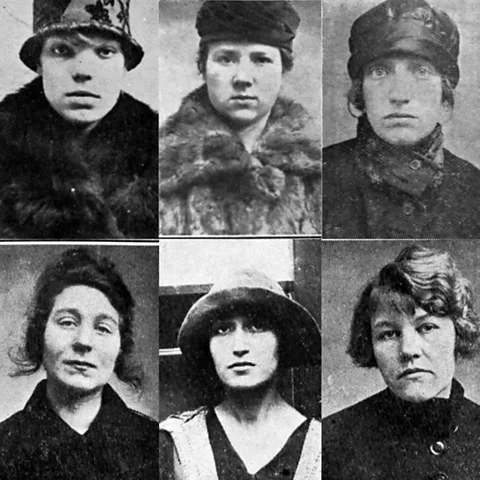 Police Gazette: National Archive
Police Gazette: National ArchiveThe code of the Elephants
The historian and author Hallie Rubenhold, who has written a number of books about women and crime, is a historical consultant on A Thousand Blows. "I had heard of the Forty Elephants, but until [joining the series], I hadn't done any real research on them," she says. "They are fascinating but very enigmatic characters. Some people have suggested they were around as early as the 18th Century, but I don't believe there has been rigorous scholarship which would confirm any of this. Of course, there were many women who were thieves and pickpockets in that period, as trial records show, but that doesn't necessarily mean there was a connection to the Forty Elephants. We only first hear about them in the 1870s."
Carr's gang was based around the Elephant and Castle area of south London, and many of its members were the girlfriends or relatives of men in a gang of thieves called the Elephant Boys. The area itself was named after a rough pub in the district. The Forty Elephants' main criminal activities were pickpocketing and shoplifting, frequently targeting London's high-end shops. Carr and associates crop up again and again in police records and trial transcripts and, occasionally, newspaper stories, typically being charged with theft and handling stolen goods.
In his book London Labour and the London Poor, published in 1851, the journalist and campaigner Henry Mayhew identified the Elephant and Castle as a crime hotspot and also described the sort of shoplifting methods often employed by Carr and the Elephants. Two or three women would go into a store when it was busy and ask to look at some of its wares: "They will likely ask to see some other goods, and keep looking at the different articles until they get a quantity on the counter. When the shopman is engaged getting some fresh goods from the window, or from the shelves, one of them generally contrives to slip something under her cloak or shawl, while the other manages to keep his attention abstracted."
They wore clothes specially adapted to facilitate theft. "We frequently find the skirt of their dress lined from the pocket downward, forming a large repository all around the dress, with an opening in front, where they can insert a small article, which is not observed in the ample crinoline," Mayhew wrote.
"People often expected women to be more honest and law-abiding, which would have given the Elephants an advantage when they went on one of their raids," says Rubenhold. "Their operation seems to have been more sophisticated and organised than simply opportunist theft."
More like this:
• Is Peaky Blinders the most violent show on TV?
The Elephants also became expert in a form of blackmail. Mary or one of her gang would lure an elderly gentleman into an alley and then accuse him of attacking her and threaten to go to the police. Other gang members would appear and claim to have witnessed the "attack". The victim would usually part company with his valuables in order to avoid embarrassment.
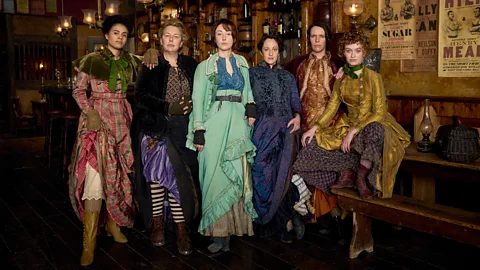 Disney+
Disney+Another element which set the Elephants apart from other criminals was the fact that they apparently had a set of rules, known as the "hoister's code" – "hoist" being their term for shoplifting. All members of the Elephants were expected to adhere to these rules. According to McDonald, they were written down by a male associate of a family connected with the Elephants with the intention of selling them to the press, but they were never published. The rules included:
"No drinking before a raid, and early hours to bed."
"Proceeds from a job are equally shared by the group members involved, no matter what their role."
"Members must not steal from each other (their money or boyfriends)."
"The Forties was a kind of co-op," wrote McDonald. "The Queen may have been the unequivocal leader, but the equal share of booty and the communal funds available to those arrested helped to foster a sense of equality and to knit the syndicate together. The stricture not to steal each other's boyfriends – not always observed – was similarly designed to maintain group harmony."
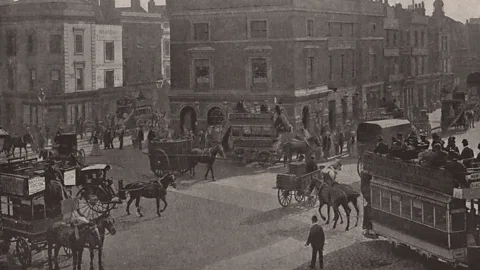 Alamy
AlamyDiamond rings and Alice Diamond
Carr's grip on the gang seems to have been lessened after a case in 1896 in which she was charged with and convicted of the kidnapping of a six-year-old boy, Michael Magee, from Epsom races. According to McDonald, Carr appeared in court "in a splendid black velvet cloak, trimmed with fur, over a black silk dress, her head adorned by a broad-brimmed Rembrandt hat boasting five ostrich feathers. On her fingers glittered seven diamond rings, valued by one journalist at more than £300, at a time when a working man's wage was less than £2 a week." McDonald surmises that the child was sold by his mother to a gangster who placed him in Carr's care with the intention of selling him on to a childless couple. The youngster was found at Carr's home 10 months after his disappearance, following an anonymous tip-off to the police. Carr was found guilty and sentenced to three years in prison. Michael's mother apparently did not want the boy back and he was taken into care.
After Mary's release, she was arrested again in 1900 for receiving stolen goods and was sentenced to two years. Thereafter, it was a downward spiral. McDonald reports that she was implicated in the 1909 robbery of a jeweller's shop in Ludgate Circus, London, but not convicted. Later, she is believed to have been "working" in the Manchester area, where, posing as socialite Lady Mary Carr, she was invited to the sort of functions where an accomplished thief and con artist might spend a profitable couple of hours. She is thought to have died in 1924 – but the Forty Elephants did not die with her.
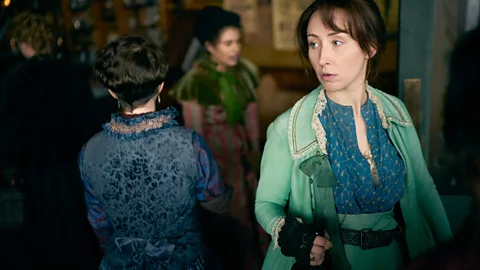 Disney+
Disney+One of Carr's successors as queen of the gang was Alice Diamond, who also features as a character in The Thousand Blows, Knight having used a bit of artistic licence with the timelines. Diamond was born in 1886 to criminal parents in Lambeth Workhouse. At the age of 17 she was convicted of stealing from a hat shop in Oxford Street, and by the age of 20 she was wearing a set of diamond rings that doubled as a knuckle duster. The Elephants had a greater propensity for violence under her rule, so there is plenty of scope for A Thousand Blows to be a returning drama, much like Peaky Blinders.
"Season two is already shot, and I'm very keen to continue telling the story because there's a lot more story to tell," says Knight. "There were still people who identified themselves as Forty Elephants in the 1950s. The truth and reality are much more interesting than anything you can invent."
A Thousand Blows launches on Disney+ in the UK and Hulu in the US on 21 February.
--
If you liked this story, sign up for The Essential List newsletter – a handpicked selection of features, videos and can't-miss news, delivered to your inbox twice a week.
